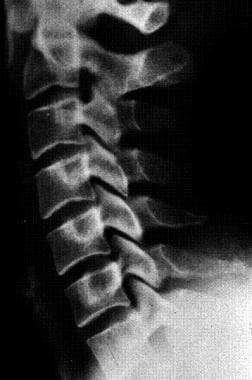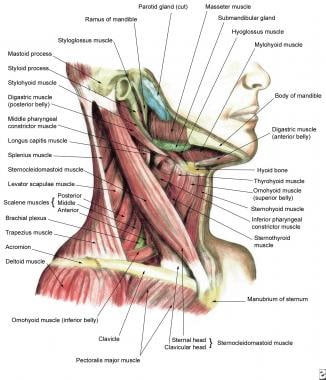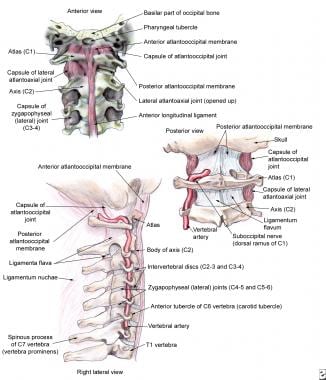Frohna WJ. Emergency department evaluation and treatment of the neck and cervical spine injuries. Emerg Med Clin North Am. 1999 Nov. 17(4):739-91, v. [QxMD MEDLINE Link].
Wiangkham T, Duda J, Haque S, Madi M, Rushton A. The Effectiveness of Conservative Management for Acute Whiplash Associated Disorder (WAD) II: A Systematic Review and Meta-Analysis of Randomised Controlled Trials. PLoS One. 2015. 10 (7):e0133415. [QxMD MEDLINE Link].
Sarrami P, Armstrong E, Naylor JM, Harris IA. Factors predicting outcome in whiplash injury: a systematic meta-review of prognostic factors. J Orthop Traumatol. 2017 Mar. 18 (1):9-16. [QxMD MEDLINE Link]. [Full Text].
Schleicher P, Pingel A, Kandziora F. Safe management of acute cervical spine injuries. EFORT Open Rev. 2018 May. 3 (5):347-357. [QxMD MEDLINE Link].
Desai S, Liu C, Kirkland SW, Krebs LD, Keto-Lambert D, Rowe BH. Effectiveness of Implementing Evidence-based Interventions to Reduce C-spine Image Ordering in the Emergency Department: A Systematic Review. Acad Emerg Med. 2018 Jun. 25 (6):672-683. [QxMD MEDLINE Link].
Galasko CSB, Murray P, Stephenson W. Incidence of whiplash-associated disorder. BCMJ. Jun 2002. 44(5):237-240. [Full Text].
Ngatchou W, Beirnaert J, Lemogoum D, Bouland C, Youatou P, Ramadan AS, et al. Application of the Canadian C-Spine rule and nexus low criteria and results of cervical spine radiography in emergency condition. Pan Afr Med J. 2018. 30:157. [QxMD MEDLINE Link].
Saragiotto BT, Michaleff ZA. The Canadian C-Spine Rule. J Physiother. 2016 Jul. 62 (3):170. [QxMD MEDLINE Link].
Thoomes EJ, van Geest S, van der Windt DA, Falla D, Verhagen AP, Koes BW, et al. Value of physical tests in diagnosing cervical radiculopathy: a systematic review. Spine J. 2018 Jan. 18 (1):179-189. [QxMD MEDLINE Link].
Spitzer WO, Skovron ML, Salmi LR, et al. Scientific monograph of the Quebec Task Force on Whiplash-Associated Disorders: redefining "whiplash" and its management. Spine. 1995 Apr 15. 20(8 Suppl):1S-73S. [QxMD MEDLINE Link].
Conforti M, Fachinetti GP. High power laser therapy treatment compared to simple segmental physical rehabilitation in whiplash injuries (1° and 2° grade of the Quebec Task Force classification) involving muscles and ligaments. Muscles Ligaments Tendons J. 2013 Apr. 3(2):106-11. [QxMD MEDLINE Link]. [Full Text].
Blackmore CC, Mann FA, Wilson AJ. Helical CT in the primary trauma evaluation of the cervical spine: an evidence-based approach. Skeletal Radiol. 2000 Nov. 29(11):632-9. [QxMD MEDLINE Link].
Grogan EL, Morris JA Jr, Dittus RS, et al. Cervical spine evaluation in urban trauma centers: lowering institutional costs and complications through helical CT scan. J Am Coll Surg. 2005 Feb. 200(2):160-5. [QxMD MEDLINE Link].
Resnick S, Inaba K, Karamanos E, Pham M, Byerly S, Talving P, et al. Clinical relevance of magnetic resonance imaging in cervical spine clearance: a prospective study. JAMA Surg. 2014 Sep. 149 (9):934-9. [QxMD MEDLINE Link].
Grunau BE, Dibski D, Hall J. The daunting task of "clearing" the cervical spine. CJEM. 2012 May. 14 (3):187-92. [QxMD MEDLINE Link].
Arbuthnot M, Mooney DP. The sensitivity and negative predictive value of a pediatric cervical spine clearance algorithm that minimizes computerized tomography. J Pediatr Surg. 2017 Jan. 52 (1):130-135. [QxMD MEDLINE Link].
Vahldiek JL, Thieme S, Hamm B, Niehues SM. Incidence of combined cranial and cervical spine injuries in patients with blunt minor trauma: are combined CT examinations of the head and cervical spine justified?. Acta Radiol. 2017 Jul. 58 (7):856-860. [QxMD MEDLINE Link].
Malhotra A, Durand D, Wu X,et al. Utility of MRI for cervical spine clearance in blunt trauma patients after a negative CT. Eur Radiol. 2018 Jul. 28 (7):2823-2829. [QxMD MEDLINE Link].
Khwaja SM, Minnerop M, Singer AJ. Comparison of ibuprofen, cyclobenzaprine or both in patients with acute cervical strain: a randomized controlled trial. CJEM. 2010 Jan. 12(1):39-44. [QxMD MEDLINE Link].
Ricciardi L, Stifano V, D'Arrigo S, Polli FM, Olivi A, Sturiale CL. The role of non-rigid cervical collar in pain relief and functional restoration after whiplash injury: a systematic review and a pooled analysis of randomized controlled trials. Eur Spine J. 2019 Aug. 28 (8):1821-1828. [QxMD MEDLINE Link].
Borchgrevink GE, Kaasa A, McDonagh D, Stiles TC, Haraldseth O, Lereim I. Acute treatment of whiplash neck sprain injuries. A randomized trial of treatment during the first 14 days after a car accident. Spine. 1998 Jan 1. 23(1):25-31. [QxMD MEDLINE Link].
Kongsted A, Qerama E, Kasch H, et al. Neck collar, "act-as-usual" or active mobilization for whiplash injury? A randomized parallel-group trial. Spine. 2007 Mar 15. 32(6):618-26. [QxMD MEDLINE Link].
Pape E, Hagen KB, Brox JI, Natvig B, Schirmer H. Early multidisciplinary evaluation and advice was ineffective for whiplash-associated disorders. Eur J Pain. 2009 Jan 30. [QxMD MEDLINE Link].
Patel KC, Gross A, Graham N, Goldsmith CH, Ezzo J, Morien A, et al. Massage for mechanical neck disorders. Cochrane Database Syst Rev. 2012 Sep 12. 9:CD004871. [QxMD MEDLINE Link].
Durall CJ. Therapeutic exercise for athletes with nonspecific neck pain: a current concepts review. Sports Health. 2012 Jul. 4(4):293-301. [QxMD MEDLINE Link]. [Full Text].
Brose SW, Jennings DC, Kwok J, Stuart CL, O'Connell SM, Pauli HA, et al. Sham manual medicine protocol for cervical strain-counterstrain research. PM R. 2013 May. 5(5):400-7. [QxMD MEDLINE Link].
Klein R, Bareis A, Schneider A, Linde K. Strain-counterstrain to treat restrictions of the mobility of the cervical spine in patients with neck pain: a sham-controlled randomized trial. Complement Ther Med. 2013 Feb. 21(1):1-7. [QxMD MEDLINE Link].
Myrtveit SM, Skogen JC, Petrie KJ, Wilhelmsen I, Wenzel HG, Sivertsen B. Factors Related to Non-recovery from Whiplash. The Nord-Trøndelag Health Study (HUNT). Int J Behav Med. 2013 Sep 19. [QxMD MEDLINE Link].
Clanchy KM, Tweedy SM, Tate RL, Sterling M, Day MA, Nikles J, et al. Evaluation of a novel intervention to improve physical activity for adults with whiplash associated disorders: Protocol for a multiple-baseline, single case experimental study. Contemp Clin Trials Commun. 2019 Dec. 16:100455. [QxMD MEDLINE Link]. [Full Text].
Nieto R, Miró J, Huguet A. Pain-Related Fear of Movement and Catastrophizing in Whiplash-Associated Disorders. Rehabil Psychol. 2013 Sep 16. [QxMD MEDLINE Link].
Beazell JR, Magrum EM. Rehabilitation of head and neck injuries in the athlete. Clin Sports Med. 2003 Jul. 22(3):523-57. [QxMD MEDLINE Link].
Bourbeau R, Desjardins D, Maag U, Laberge-Nadeau C. Neck injuries among belted and unbelted occupants of the front seat of cars. J Trauma. 1993 Nov. 35(5):794-9. [QxMD MEDLINE Link].
Bylund PO, Bjornstig U. Sick leave and disability pension among passenger car occupants injured in urban traffic. Spine. 1998 May 1. 23(9):1023-8. [QxMD MEDLINE Link].
Calliet R. Neck and Arm Pain. 2nd ed. FA Davis Co; 1981.
Daffner RH. Controversies in cervical spine imaging in trauma patients. Emerg Radiol. 2004 Aug. 11(1):2-8. [QxMD MEDLINE Link].
Davis CG. Injury threshold: whiplash-associated disorders. J Manipulative Physiol Ther. 2000 Jul-Aug. 23(6):420-7. [QxMD MEDLINE Link].
Dickinson G, Stiell IG, Schull M, et al. Retrospective application of the NEXUS low-risk criteria for cervical spine radiography in Canadian emergency departments. Ann Emerg Med. 2004 Apr. 43(4):507-14. [QxMD MEDLINE Link].
Dreyer SJ, Boden SD. Laboratory evaluation in neck pain. Phys Med Rehabil Clin N Am. 2003 Aug. 14(3):589-604. [QxMD MEDLINE Link].
Griffiths HJ, Olson PN, Everson LI, Winemiller M. Hyperextension strain or "whiplash" injuries to the cervical spine. Skeletal Radiol. 1995 May. 24(4):263-6. [QxMD MEDLINE Link].
Hoffman JR, Schriger DL, Mower W, Luo JS, Zucker M. Low-risk criteria for cervical-spine radiography in blunt trauma: a prospective study. Ann Emerg Med. 1992 Dec. 21(12):1454-60. [QxMD MEDLINE Link].
Kappler RE. Cervical Spine. Ward RC, et al, eds. Foundations for Osteopathic Medicine. Lippincott, Williams & Wilkins; 1997. 541-546.
Ladig D, DeBell LS, Hubert MK. Mosby's Complete Drug Reference 1997. Physicians GenRx. Mosby-Year Book, Inc; 1997.
Martinez JA, Timberlake GA, Jones JC, et al. Factors affecting the cervical prevertebral space in the trauma patient. Am J Emerg Med. 1988 May. 6(3):268-72. [QxMD MEDLINE Link].
McMorland G, Suter E. Chiropractic management of mechanical neck and low-back pain: a retrospective, outcome-based analysis. J Manipulative Physiol Ther. 2000 Jun. 23(5):307-11. [QxMD MEDLINE Link].
McSwain NE, Martinez JA, Timberlake GA. Cervical Spine Trauma: Evaluation and Acute Management. 1989.
Patel RV, DeLong W Jr, Vresilovic EJ. Evaluation and treatment of spinal injuries in the patient with polytrauma. Clin Orthop Relat Res. 2004 May. 43-54. [QxMD MEDLINE Link].
Richards PJ. Cervical spine clearance: a review. Injury. 2005 Feb. 36(2):248-69; discussion 270. [QxMD MEDLINE Link].
Shaffer MA, Doris PE. Limitation of the cross table lateral view in detecting cervical spine injuries: a retrospective analysis. Ann Emerg Med. 1981 Oct. 10(10):508-13. [QxMD MEDLINE Link].
Stiell IG, Clement CM, McKnight RD, et al. The Canadian C-spine rule versus the NEXUS low-risk criteria in patients with trauma. N Engl J Med. 2003 Dec 25. 349(26):2510-8. [QxMD MEDLINE Link].
Sturzenegger M, DiStefano G, Radanov BP, Schnidrig A. Presenting symptoms and signs after whiplash injury: the influence of accident mechanisms. Neurology. 1994 Apr. 44(4):688-93. [QxMD MEDLINE Link].
Van Goethem JW, Maes M, Ozsarlak O, van den Hauwe L, Parizel PM. Imaging in spinal trauma. Eur Radiol. 2005 Mar. 15(3):582-90. [QxMD MEDLINE Link].
Wang JC, Hatch JD, Sandhu HS, Delamarter RB. Cervical flexion and extension radiographs in acutely injured patients. Clin Orthop Relat Res. 1999 Aug. 111-6. [QxMD MEDLINE Link].
Zmurko MG, Tannoury TY, Tannoury CA, Anderson DG. Cervical sprains, disc herniations, minor fractures, and other cervical injuries in the athlete. Clin Sports Med. 2003 Jul. 22(3):513-21. [QxMD MEDLINE Link].











